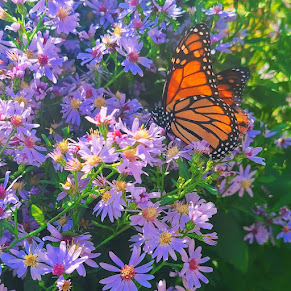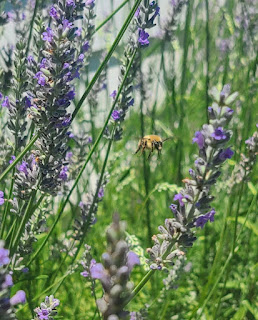I have been working with European honey bees for almost 13 years now. Some of the things that I love the most are the challenges that present themselves. The dramas of the hive such as queens attacking their sisters, would be invaders being stung to death and then mummified, and the pushing out of the male bees at the onset of the winter for them to starve death are all fascinating. And of course, the sweet, sweet, honey reward. Of course, European honey bees are not native to the United States nor are they even close to our only pollinators. The first hive was brought over on the Mayflower and later spread throughout North America being called the ‘white man’s flies’ by the indigenous communities.
Virginia is home to over 450 native bees that have co-evolved with our native plants tocontribute greatly to their pollination. They are for the most part not social like honeybees and have a wide range of interesting ways to raise their young independently witheach female making their own nests for their developing brood. Some bees dig holes inthe ground and line their nests with leaves or make a cellophane like substance. Othersuse hollow stems or burrows in logs, and bumble bees re-purpose old mouse burrows.They come in different sizes and colors ranging from bright metallics like the Sweat Beeto dull oranges, browns, and blacks like the Two-spotter Longhorn Bee. Perdita minimais the tiniest bee at only 2 mm in length and our biggest coming in at almost an inch, arethe Common Bumble Bees. None of our native bees make honey, only small packets offood for their young. But they make better pollinators than honey bees for the most partas they have evolved with the native flowers and have different length tongues and have different strategies, like the bumblebee who uses buzz pollination to shake the pollen out of flowers. But wait! You’re sitting and looking at your beautiful ox-eye daisies and you notice something that does not have the body shape of a bee…. Wasps, beetles, moths, butterflies, flies, and even birds pollinate flowers while trying to grab either that sugar fueled nectar reward, using the flower as a base to prowl and eat other insects, or by grabbing up some protein rich pollen. The stink horn cabbage’s bloom smells like rotten meat and blooms in February while the days are still frigid and couldn’t be pollinated by anything other than flies! Scientists are still trying to scout out and count the most likely thousands of pollinators other than bees. I believe I sometimes count as a pollinator as I walk through fields during the summer, brushing past flowers, eventually being covered in yellow from the head down.
 Without this network of a mostly invertebrate, flower loving community, we would be doomed to a life without 75% of our fruits, nuts and vegetables. Over 100 crops in the United States alone depending on pollination. And yet, in a short 5-year study (2008-2013), wild bees declined by 23% across the United States. All over the world, scientists are reporting staggering decline in insect numbers in general. Habitat loss, climate change, and pesticide use are all slowly working against these small but mighty beasts that keep our species going. Although one person, one garden can not reverse what is occurring in our ecosystem, we can do some things that combined, may be the literal life and death of a localized community of insects in your area. Planting native plants of all kinds that bloom at different times of the year allows access to food for these insects during all seasons. Reduce or eliminate pesticide use around your garden. Build brush piles and leave some areas wild. Additionally turning off your outside lights when you go to bed can reduce confusion for night flying insects. There are also a few citizen science projects that are already approved like Budburst and Bumblebee Watch to help count and monitor pollinators so scientists can monitor the changes and declines of our important insects. Either way, go out, find a flower or two, and sit in amazement as something so small that contributes something so important to us all!
Without this network of a mostly invertebrate, flower loving community, we would be doomed to a life without 75% of our fruits, nuts and vegetables. Over 100 crops in the United States alone depending on pollination. And yet, in a short 5-year study (2008-2013), wild bees declined by 23% across the United States. All over the world, scientists are reporting staggering decline in insect numbers in general. Habitat loss, climate change, and pesticide use are all slowly working against these small but mighty beasts that keep our species going. Although one person, one garden can not reverse what is occurring in our ecosystem, we can do some things that combined, may be the literal life and death of a localized community of insects in your area. Planting native plants of all kinds that bloom at different times of the year allows access to food for these insects during all seasons. Reduce or eliminate pesticide use around your garden. Build brush piles and leave some areas wild. Additionally turning off your outside lights when you go to bed can reduce confusion for night flying insects. There are also a few citizen science projects that are already approved like Budburst and Bumblebee Watch to help count and monitor pollinators so scientists can monitor the changes and declines of our important insects. Either way, go out, find a flower or two, and sit in amazement as something so small that contributes something so important to us all!
Article and photos submitted by Jesssica Driver
References:
https://www.monticello.org/research-education/thomas-jefferson-encyclopedia/bees-and-honey/#:~:text=The%20bees%20have%20generally%20extended%20themselves%20into%20the,the%20approach%20of%20the%20settlements%20of%20the%20whites.
https://www.dcr.virginia.gov/insights/protecting-the-pollinator-population
https://www.usda.gov/pollinators
https://www.usda.gov/media/blog/2016/06/24/reversing-pollinator-decline-key-feeding-future
https://www.npr.org/sections/goatsandsoda/2022/02/24/1082752634/the-insect-crisis-oliver-milman#:~:text=Habitat%20loss%2C%20pesticides%20and%20climate%20change%20are%20threatening,and%20that%20a%20third%20of%20them%20are%20endangered.







No comments:
Post a Comment